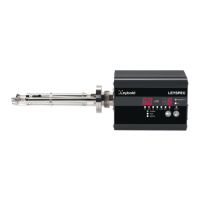83 300781172_002_C0 - 01/2019 - © Leybold
Appendix
13.5 Peaks of major residual gases
m/z Ion
Residual gas
molecule
Remark
1H+ H
2
, vapour,
Hydrocarbon
2H2+ H
2
, vapour,
Hydrocarbon
H dissociated from various
molecules are recombined.
12 C+ CO, CO
2
,
Hydrocarbon
14 N
2
++, CO++
CH
2
+
N
2
, CO, Hydrocarbon
15 CH
3
+ Hydrocarbon having
methyl base
16 O
2
++, O+ CH
4
+CH
4
, O
2
, oxygen
compound
17 OH+ H
2
OWith H
2
O ratio is 16 : 17 : 18=1 :
5 : 20
18 H
2
O+ H
2
O
20 Ar++, (H
2
O) Ar, (H
2
O) H
2
O (20) with O18 abundance
ratio of about 0.2% is present.
22 CO
2
++ CO
2
27 C
2
H
3
+ Hydrocarbon
28 CO+, N
2
C
2
H
4
++ CO, N
2
, Hydrocarbon Hydrocarbon (28) is 5 to 10 times
hydrocarbon (27). When CO
2
(44)
is high, CO (28) is also high.
29 C
2
H
3
+, (N
2
+),
(CO )+
Hydrocarbon, (N
2
)
(CO)
Abundance ratio of N13 is 0.3%.
Abundance ratio of C13 is 1.1%.
30 NO+ Appears immediately after
evacuation of a contaminated
vacuum system.
32 O
2
+O
2
Air leak when 28:32 = 4:1.
35 Cl+ Halogen type
detergent
Cl35: Cl37 = 3:1
37 (Cl)+ Halogen type
detergent
39 C
3
H
3
+ Hydrocarbon
40 Ar+, C
3
H
4
+ Hydrocarbon, Ar Abundance ratio of Ar in air is
about 1%.
41 C
3
H
5
+ Hydrocarbon C
3
type hydrocarbon appears at
36 to 44, especially much at 39,
41 and 43.
42 C
3
H
6
+ Hydrocarbon
43 C
3
H
7
+ Hydrocarbon
44 CO
2
+ Hydrocarbon, CO
2
Some CO
2
peaks of C13 and
O18 appear at 45 and 46.
50 C
4
H
2
+ Hydrocarbon
especially aromatic
groups
51 C
4
H
3
+ Hydrocarbon,
especially aromatic
groups

